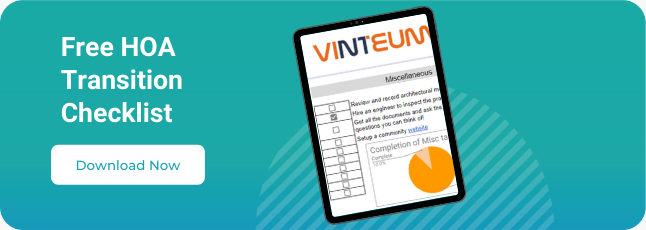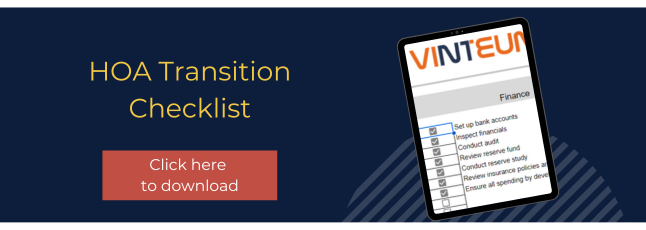Transitioning from a developer-controlled association to a resident-controlled homeowners association can be difficult. Here we examine this process, looking at different roles challenges, and responsibilities, and how you can make this change easier with our HOA transition checklist.
What is an HOA Transition?
An early milestone in the lifecycle of an association is when the developer has to hand over control to the residents. A developer can control the association for months or even years, they commit a huge amount of resources to both the construction and the infrastructure. Therefore they often build provisions into the association’s legal documents so they can control the direction until either a set date or when a certain percent of the units have been sold.
The Developer’s Role
If the developer is a good one then they should be involving and training homeowners from the beginning, and creating advisory committees. The transition from the developer happens at a special meeting, and what changes is that the developer is no longer in control. They will probably still be involved in the association, possibly selling units and they may retain seats on the Board. However the people in charge will now be the board of directors.
The Board’s Role
The new board has a huge responsibility in the association’s transition to being member controlled, they ensure that the developer gives them all the necessary information that they’ll need to run the HOA. They need to review the information and ask the developer questions about anything vague or unclear in any documents. Finally, they have to come up with a strategic plan. This involves a lot of work, and nothing can be forgotten or left until the last minute.
HOA Transition Challenges
As this 2014 report by the Community Association Institute on Best Practices: Transition highlights, there are many challenges during an HOA transition.
Construction
The developer’s role is to build the HOA, so construction is very important as your HOA grows. The board’s focus is on the quality of the construction, whereas the builders want to finish quickly to maximize profits. This can cause tension, and has led many builders to hire consultants to reduce the amount of work they have to redo.
Governance
Ideally, the control over the governance of the homeowners’ association is slowly transitioned from the developer to the board. That way the board has time to do audits and understand the situation before everything is handed over to them. In some states, there are regulations around when this handover of control happens.
Documentation
All community associations require a body of governing documents which lay down the rules of the HOA. They also include:
- Articles of incorporation
- Declaration of covenants, conditions & restrictions (CC&Rs)
- Bylaws
These need to be drawn up as early as possible, as many local governments check them, and the board also needs to audit them. If and when a professional management company is involved, they should also review them.
How Can an HOA Transition Checklist Help?
Organization is key during your association’s transition to being member-controlled. You need to coordinate with different moving parts, including the developer, board members, vendors, and professionals. You also need to read and understand a lot of different information, including governing documents, financial and legal information. It’s also very important to tour the project, fix any issues and start to create maintenance plans that will help you and future boards.
There is a lot to do, and having tools will help. So we created a free HOA transition checklist that you can download, share with other stakeholders, and use to keep up with different tasks. You include what the task is, when the deadline is, and who is in charge of doing that task. There’s a graph that tells us how close you are to finishing all the tasks in that category, so you can easily see how close you are.
Wrapping up HOA Transition Checklist
Your HOA’s transition from developers to members is an important time when a lot is happening. It’s important that the board knows what the developer’s role is and what they need to do. They should also have a clear idea of the challenges and outcomes.
Using an HOA transition checklist makes it easier to organize tasks and see what needs to be done when, and by who. When the board has more control and confidence, they should look into having a website to help them communicate with residents, and improve engagement and transparency.
We can also help you communicate better with each other and with residents, store documents and important information, and improve general management using our software, Neigbrs by Vinteum. We’re the only communication-focused software in the market, which can make all the difference during the transition phase, and beyond. Set up your free demo with no strings attached.





